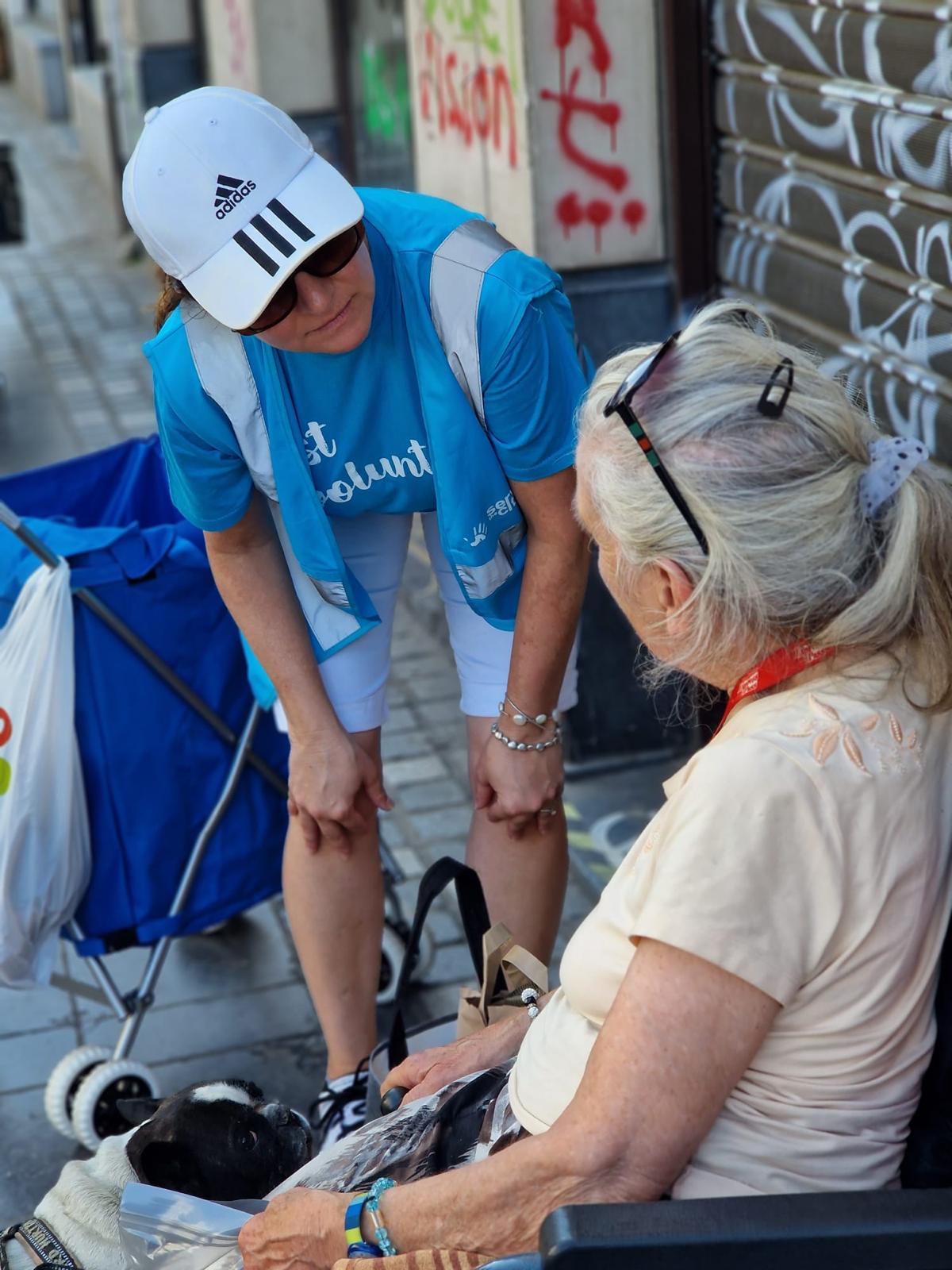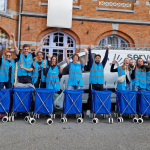Natalia’s journey into volunteering began early in life, inspired by a desire to help others after a childhood experience in Colombia. Growing up in a country with severe inequalities, she developed a deep sensitivity to the struggles of those in need. Over eight years ago, Natalia joined Serve the City, where she has since been one of the main leaders of the Street Kindness distribution, and worked with various vulnerable communities. Through her volunteering, Natalia has learned invaluable lessons about empathy and human connection, understanding the profound impact on both those helped and the volunteers themselves.
How did you become interested in volunteering?
NM: I started very early—not by volunteering. I remember the first thing I did for others was during my first Communion. I was in a Catholic school, and the nuns told us that having a first Communion was a privilege. They said we didn’t need to throw a party to celebrate; instead, we could think of others. After that, I told my mum that I didn’t want a party. I wanted to give toys to children who didn’t have any.
So, we bought two big boxes of dolls and cars and went to a very poor neighbourhood, similar to a favela, in Bogotá. We knocked on doors, asking how many kids lived in each house and inviting them to come choose a car or a doll. Soon, we ran out of toys, and I saw many children running toward us, hoping for something. But we had nothing left. I was shocked and realized for the first time that I couldn’t help everyone. I was eight years old, and that was when I understood how nice it is to give to others.
This desire to help others started early in my life. In Colombia, you’re constantly exposed to the contrast between the haves and have-nots. Growing up there gave me this sensitivity. So, becoming a volunteer was never a question for me.
Could you please share how long you’ve been a volunteer with STC and what initially drew you to our organization?
NM: I started eight and a half years ago when my kids were attending the German School. At the school, there were people involved in social programs, and I was invited to join a group of mothers who participated in the Big Volunteer Days from Serve the City. They explained to me that Serve the City was an organization where people volunteered once a month on Saturdays. I thought, “That sounds nice,” and decided to give it a try.
At first, I didn’t know much about Serve the City, but as I got involved, I started meeting people like Nathan, Sara, and others. Through them, I learned more about what Serve the City was all about. I remember thinking, “Wow, this is exactly the kind of thing I want to be part of.”.
What have you learnt from volunteering?
NM: I think the most powerful thing I’ve learned is not to have prejudices and not to be judgmental because we never know who is in front of us. People have amazing and sad stories. Another thing I’ve learned is that even though we might be in different situations, we are the same and have the same needs.
When did you become a project leader?
NM: I am not sure of the dates, but i know it was before COVID.
What projects are you working on?
NM: I am one of the project leaders for Street Kindness, which is the most important project I’m involved in. I also help out at the office with CSR (Corporate Social Responsibility). When I first started, I did other things as well, like working with Petites Sœurs des Pauvres. I was also involved in a project near Gare du Midi, which was a kitchen run by Polish nuns. Before COVID, I started another project called Hama4—I’m not sure if it existed before, but I lived in the neighbourhood, and when COVID came, it stopped.
What are the biggest difficulties you’ve faced in these projects?
NM: One of the challenges I’ve encountered is when people are not able to maintain cleanliness, which can make it difficult to approach them. The strong smell can create a bit of a barrier to having a conversation or offering coffee, tea, or a sandwich. It’s not that I judge the situation, but it can make the interaction more challenging.
I also want to emphasize that I’ve never experienced violence while Street Kindness and I recognize that the people I meet are not violent and I feel safe, which is a reassuring experience for me.
As a woman you feel safe doing the project?
NM: Yes!
Are there any stories you’ve experienced or been told by a benefactor that still resonate with you?
NM: Yes, they are a couple of them. There are also two women who, despite how hard the street can be, are always in a good mood and willing to receive the sympathy of the people who stop to talk to them. The first woman is Nur, from Madagascar. I met her for the first time years ago in Gare de Midi. When I told her I was Colombian, she asked me if I ate meat from an animal that they eat in Ecuador and southern Colombia. We laughed at my answer and from that day on we had a special connection. Going to the place where Nur was sitting was a must stop when I went with the project to Gare de Midi, but also when I went for personal reasons. Nur lived for years outside the station, among cardboard and piles of things she collected. She always greeted me with a smile. She was the first person in which I saw how mental health declines in people who live on the street for a long time. Because I never saw her with friends, I think she was a very lonely woman. She had a pigeon as her pet. On Christmas, I even brought her a framed picture with a photo of her with her pigeon. Nur passed away two years ago.
And Jacqueline, a fantastic, charming old lady, who will turn 92 on Valentin’s day. She was part of a group that before COVID used to sit at the main gate of Gare Centrale. One day when we were starting to resume Street Kindness after COVID and explore new routes different from the center, I met Jacqueline on the avenue Louise, and she recognized me. I don’t understand how a Belgian woman of that age – who supposedly has a roof over her head that she shares with her nephew- is forced to beg for food! I love talking to Jacqueline, she has many stories and can talk for hours non-stop. Sometimes she corrects my French, which I appreciate very much. Although she cannot eat many of the food we bring with the project due to health reasons, you could surprise her by bringing her a portion of tarte au riz or a cramique from Paul! I have seen her several times at 11 p.m. at her spot and she tells me that she stays that late to collect some money from the people leaving the restaurants. Although Jacqueline is very loved in her area and many people bring her things to eat, drink and stop for a chat, there are also those who approach her to steal her coins or throw them on the ground. Unfortunately, she can’t pick up the coins on the floor by herself from her wheelchair.


What motivates you to continue volunteering?
NM: I believe that what we give creates a special moment, not only for the people we help, but also for us as volunteers. We give a lot, but we also receive just as much. Over the years, I’ve realized how lonely people can be on the streets. Sometimes, just going over to chat with them for a moment can make a difference. You may not change their life, but maybe you can change their day. You might give them a brief moment of connection, and that could be the only conversation they have all day, or the only meal they’ll receive, or the only kindness they’ll experience. That’s why I continue volunteering.
Why do you think volunteering is important?
NM: Because we need to be able to step into each other’s shoes and understand other people’s situations. We need to realize that there are other realities out there. It’s not just our world, our reality, or our privilege that exists; there are people living in very different circumstances. Volunteering gives you the opportunity to see that.
I’ve also realized that calling someone “homeless” isn’t entirely correct. In California, they started using the term “unhoused”, which seems more accurate. These people are in their situation because of life circumstances, but it’s easy to see how any of us could end up in that position. Today, we may have a job and a home, but tomorrow, who knows? You could lose your job, your home, and suddenly be in the same situation. Volunteering in these projects makes you realize that it could happen to any of us.
What positive benefits have you seen in your life since you started volunteering?
NM: I am more aware; I have more empathy without judgment.
What is your favorite thing about volunteering?
NM: Hmm… I think one of my favorite things is briefing the volunteers. When the groups start here at the STC office, there’s so much motivation, and everyone is expecting to have a great day. It’s exciting because there are plenty of things to give away: lunch bags, hygiene items, snacks, clothes, shoes, and sleeping bags.
What impact do you think volunteering has on the people that you help?
NM: It’s a moment of profound relief when we deliver the lunch bags and essentials like clothes, socks, and hats—especially now, with the cold. You can see the relief on their faces . When they’re truly hungry and in difficult situations, they even bless us. For me, hearing those words of gratitude, like “Dieu vous bénisse” [God bless you], is deeply moving. It’s a reminder of the humanity we share and the impact that small acts of kindness can have.







